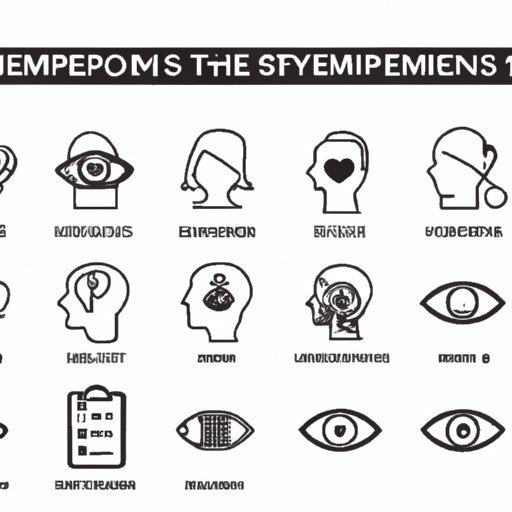
Introduction
Signs and symptoms are commonly used medical terms that are often misunderstood and misused. The two terms are closely related, but they have different meanings and serve different purposes. In this article, we’ll explore the fundamental differences between signs and symptoms, their role in medical diagnosis and treatment, and how to differentiate between the two.
Signs vs. Symptoms: Understanding the Fundamental Differences
Before we distinguish the two, let’s first understand what signs and symptoms are.
Definition and examples of signs
Signs are objective observations that can be seen, heard, felt or measured by someone other than the person experiencing them. Signs can be examined and confirmed by a healthcare professional. Examples of signs include:
- A rash on the skin
- An abnormal heartbeat detected through stethoscope
- A fever temperature reading above 100.4 F
- An enlarged liver felt during a physical exam
Definition and examples of symptoms
Symptoms are subjective experiences reported by the person experiencing them, also known as the patient. They cannot be verified by someone else, but they can be described and evaluated by healthcare professionals. Examples of symptoms include:
- Pain in the abdomen
- Feeling fatigued
- Frequent urination
- Nausea or vomiting
Key differences between signs and symptoms
The key differences between signs and symptoms are:
- Signs are objective observations, while symptoms are subjective experiences.
- Signs can be verified by someone other than the patient, while symptoms cannot.
- Signs are often external and can be observed without the patient’s input, while symptoms are internal and can only be conveyed by the patient.
Decode Your Body: Differentiating Between Signs and Symptoms
Now, let’s explore how signs and symptoms can manifest in the body and the importance of paying attention to bodily changes.
When the body experiences any changes, it tries to signal that something is wrong or out of balance. These signals can take the form of signs or symptoms. It is crucial to pay attention to any changes that occur and report them to a healthcare provider to prevent or treat any medical conditions.
Tips on how to differentiate between signs and symptoms
Identifying signs and symptoms can be challenging as they can have similar manifestations, but the following tips can help:
- Pay attention to your body and any changes you may experience.
- Take note of how long the symptoms have been present.
- Consider if the symptoms might be related to any underlying medical conditions.
- Consult a healthcare professional for appropriate diagnosis and treatment.
Signs and Symptoms: Two Sides of the Same Medical Coin
Signs and symptoms play crucial roles in medical diagnosis and treatment.
Overview on how signs and symptoms relate to medical conditions
For healthcare professionals to diagnose and treat medical conditions, they rely on identifying the presence or absence of signs and symptoms. Signs provide physical evidence while symptoms provide evidence of how the patient is feeling or experiencing the condition. Collectively, they provide essential insights into the patient’s condition.
The importance of recognizing signs and symptoms for diagnosis and treatment
Early detection and diagnosis of medical conditions are critical for effective treatment and recovery. Identifying signs and symptoms can help healthcare professionals make an accurate diagnosis and develop the appropriate treatment plan.
The Fine Line Between Signs and Symptoms Explained
Despite their differences, identifying signs and symptoms correctly is often a challenge for both healthcare providers and patients. Let’s delve deeper into the reasons why.
Challenges of identifying signs and symptoms
One challenge in identifying signs and symptoms is that some medical conditions can have overlapping signs and symptoms. Some symptoms can even be a sign of another underlying condition. For example, Abdominal pain can be a sign of gastrointestinal problems or a symptom of kidney stones.
Discussion on how signs and symptoms can overlap
Another challenge in distinguishing between signs and symptoms is that some signs are subjective experiences that can be conveyed by the patient. For instance, a patient might tell their healthcare provider that they are experiencing pain when pressed on a certain area or that they feel bloated. These are subjective experiences that cannot be independently verified.
Tips on how to accurately identify and report signs and symptoms to healthcare professionals
To effectively identify and report signs and symptoms, the following tips can help:
- Be specific and detailed when reporting symptoms.
- Describe symptoms using objective terminology.
- Mention the duration of the symptoms, any triggers or patterns.
- Indicate any associated symptoms or body changes.
A Guide to Distinguishing Signs from Symptoms
Here is a practical guide to help you better distinguish between signs and symptoms.
Real-life examples to illustrate the differences
Example One:
You have a headache, nausea, and a fever.
A headache, nausea, and fever are examples of symptoms since they are subjective experiences and can only be described by the patient.
Example Two:
You notice that your skin is yellow, and your eyes are white.
Yellow skin and eyes are examples of signs since they are objective observations that can be verified by others.

Spotting Signs and Symptoms: What You Need to Know
Many medical conditions have common signs and symptoms that can help you identify the presence of a potential problem. Understanding these signs and symptoms can be essential in preventing, managing, and treating medical conditions.
Discussion on common signs and symptoms of various medical conditions
Here are some common signs and symptoms of various medical conditions:
- Chest pain and discomfort during exercise or when under emotional stress can be a sign of coronary artery disease.
- Shortness of breath, wheezing, and coughing can be symptoms of asthma.
- Blood in the urine and frequent urination can be signs of bladder cancer.
- Weight loss, nausea, vomiting, and abdominal pain can be symptoms of pancreatic cancer.
Practical advice for identifying and managing signs and symptoms
If you have symptoms or signs of a medical condition, it is essential to seek medical attention promptly. Early diagnoses often lead to better outcomes. Managing the symptoms can also help you feel comfortable while waiting for diagnosis and treatment.
Signs or Symptoms? Learning the Medical Jargon
Medical terminology related to signs and symptoms can be confusing, but understanding common terms can help improve communication between patients and healthcare providers.
Explanation of medical terminology related to signs and symptoms
Here are a few common terms used in medical terminology:
- Diagnosis: The identification of a medical condition
- Symptomatology: The study of symptoms in a medical sense
- Objective: Refers to facts that a healthcare professional can visually observe
- Subjective: Refers to anything that cannot be independently verified and is experienced by the patient
Discussion on how understanding medical terminology can improve patient communication and care
Understanding medical terminology can be helpful when communicating with a healthcare provider. It can help you provide more specific and detailed information about your symptoms, which can lead to a more accurate diagnosis and improved treatment.
Conclusion
Signs and symptoms are essential components in the diagnosis and treatment of medical conditions. Understanding the difference between signs and symptoms can help you better convey your symptoms to healthcare providers, which can lead to more accurate diagnoses and better treatment outcomes. By taking charge of your health and paying attention to any changes in your body, you can ensure early detection and treatment of any medical conditions.
Remember, if you notice any signs or symptoms of a medical condition, it’s crucial to seek medical attention promptly.
Call to action:
Take the time to learn about common signs and symptoms of medical conditions and how to distinguish them. Keep track of any changes in your body and report them to your healthcare provider. By being proactive and vigilant, you can ensure early detection and treatment of any medical conditions.




